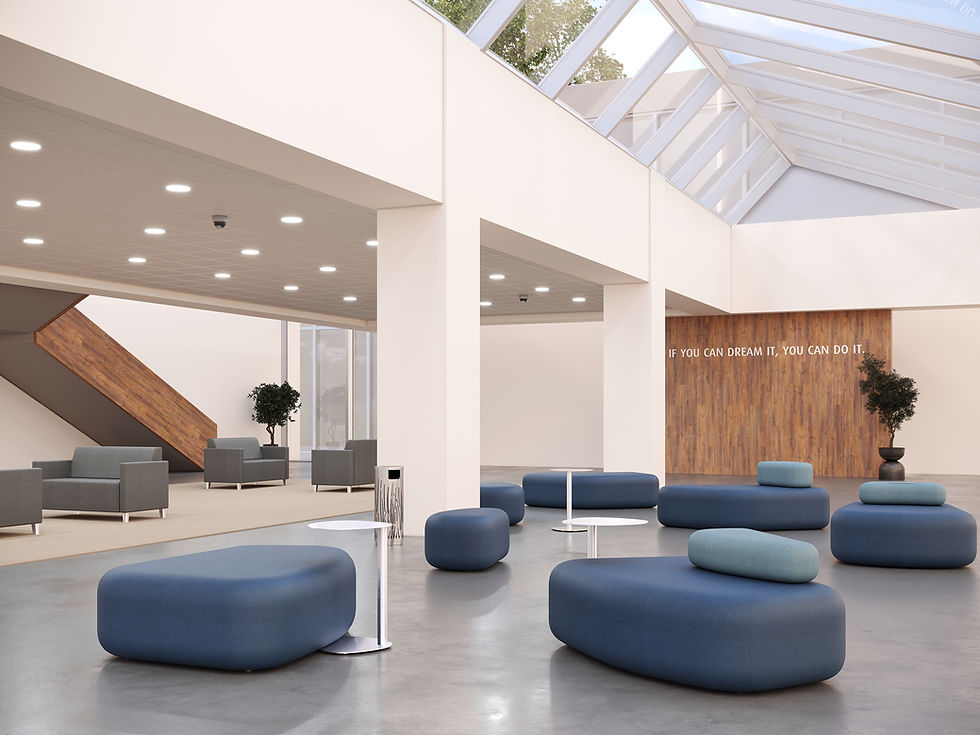Data-Driven Design: What Research Says About Comfort and Engagement
- Shalyn Henry
- 4 days ago
- 3 min read
Designing for comfort and engagement isn’t just about style; it’s about science. Studies show that choices like ergonomic seating, soft edges, and lounge-style setups can do more than make a space look good—they can boost focus, collaboration, and overall well-being. Let’s break down what the research says.
1. Enhances Comfort, Focus & Learning

Ergonomic furniture keeps people on task. Students using ergonomic seating show 12% more on-task behavior than those with traditional setups (International Journal of Educational Research, 2021). One reason? When your chair actually supports your posture, you fidget less leaving your brain more room to focus (Center for Health Design, n.d.).
Comfort reduces stress. Chairs with adjustable lumbar support have been shown to lower classroom stress by 31% and reduce anxiety markers by 22% during high-pressure moments like exams (International Journal of Educational Research, 2021). Even something as small as tilting a backrest from 90° to 100° can lower spinal disc pressure by 35%, your lower back will thank you (Center for Health Design, n.d.).
2. Flexible & Lounge-Style Seating: Movement Meets Engagement

More ways to sit = more ways to engage. When Iowa State University redesigned a lecture space into an “active learning classroom” with flexible seating, portable boards, and technology, engagement shot up—students said it made “everybody… more comfortable and able to engage” (Iowa State University, 2020).
The National Education Association (2019) found that flexible seating boosted cooperative learning by 25%, making it easier for students to work together. Plus, active seating (like stools or soft lounge chairs) keeps people physically engaged, which can help mental alertness (ResearchGate, 2022).
But here’s the twist: Different people benefit differently. Girls in flexible seating environments often report higher well-being and fewer attention issues, while boys sometimes focus better on fixed setups, meaning variety is key (Sailer & Ahn, 2022).
3. The Power of Soft Edges & Biophilic Forms

While hard numbers on soft edges are challenging to find, environmental psychology suggests that curved, organic forms signal safety and relaxation, whereas sharp corners can evoke a more formal or rigid feeling (Wallpaper, 2021). This aligns with biophilic design principles, which demonstrate that nature-inspired forms can reduce stress and keep people visually engaged.
In public space research, layouts with organic shapes and natural elements have been linked to quicker gaze orientation and reduced cognitive load; basically, they make it easier for our brains to process our surroundings (Wallpaper, 2021).
4. Layout & Spatial Configuration

How you arrange seating matters. A classic study found that circular seating boosted attention, participation, and reduced fatigue compared to rows or rectangles (Fulrath, 1976).
And here’s a pro tip from classroom design studies: Students sitting in the “prime spots” (front and center) tend to engage more and perform better than those in the back (Center for Health Design, n.d.).
Quick Takeaways for Your Space
Go ergonomic: Adjustable chairs with lumbar support improve comfort and focus.
Mix it up: Offer lounge seating, active seating, and traditional options so everyone can find their focus zone.
Soften the edges: Curves and nature-inspired shapes make spaces feel inviting.
Play with layouts: Try circular setups for discussions and group zones for collaboration.
Think well-being: Lighting, acoustics, and seating choices all add up to better engagement and performance.
References
Center for Health Design. (n.d.). The impact of ergonomics on learning and wellbeing. The Center for Health Design. https://www.healthdesign.org
Fulrath, R. (1976). Effects of classroom seating arrangements on student participation and fatigue. Educational Technology, 16(3), 45–48.
International Journal of Educational Research. (2021). The effect of ergonomic chairs on focus and engagement in classrooms. International Journal of Educational Research, 105, 101–112. https://doi.org/10.1016/j.ijer.2020.101112
Iowa State University. (2020). Active learning classroom redesign boosts engagement. Iowa State University Teaching & Learning. https://www.celt.iastate.edu
National Education Association. (2019). Flexible seating and its impact on collaboration. NEA Today. https://www.nea.org
ResearchGate. (2022). Flexible seating: Impact on classroom environment. https://www.researchgate.net/publication/357780294_Flexible_Seating_Impact_on_Classroom_Environment
Sailer, K., & Ahn, A. (2022). Gender differences in the effects of flexible seating on wellbeing and attention in primary school children. Frontiers in Psychology, 13, 821227. https://doi.org/10.3389/fpsyg.2022.821227
Wallpaper. (2021, October 28). Architecture and wellness: How design can influence our wellbeing. Wallpaper Magazine. https://www.wallpaper.com/architecture/architecture-and-wellness




Comments